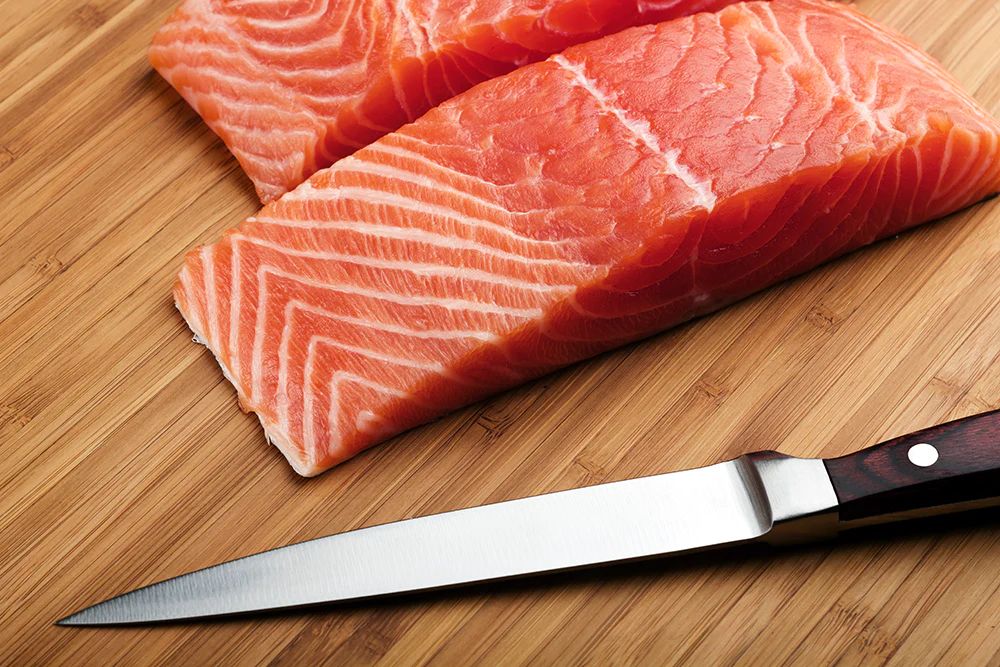Do you have a great kitchen knife collection and want to add a fillet knife to it, or do you already have one? Both ways, you should know everything from fillet knife uses to its making and specific features. A filleting knife is not only used for fish but it has plenty of uses. Because of it’s sharp blades fillet knife is one of most frequently used knives in the kitchen. Speaking of its uses, how can we miss mentioning fish filleting because no other knife can do it better than best fillet knife.

Let’s have a detailed look at the fillet knife meaning, uses, and benefits.
What Is A Fillet Knife?
The type of knife most commonly used for cutting fish is a filleting knife. The blade is very thin, flexible with a pointed tip, and slightly curved upwards at the edge. The blade is generally full tang (single steel from the edge to the handle end).
The most demanded blades in filleting knives are either German or Japanese stainless steel blades. And the knife comes in a blade size range of 6-11 inches.
What is a Fillet Knife Used for?
As apparent from its name, fillet knives are used for filleting fish and meat. Fillets simply refer to clean and boneless flat cuts of meat or fish. And filleting is just one of the many uses for fillet knives. You can use it differently, but filleting is the primary fillet knife purpose.
Without any ado, let’s dig into the different fish fillet knife uses,
Fillet Knife: A Fish Master
Filleting fish is not just about slicing fish and cutting it into pieces. It begins with gutting and scaling, then filleting, deboning, and skinning fish. And what if we say a fillet knife can handle all these tasks single-handedly? Remove the scales using the blunt edge of the knife and then cut the belly to remove the guts. The thin and sharp blade will help gain clean fish fillets and effortlessly remove the scales. Here comes the fun part, as skinning fillets is indeed an easy peasy task with a filleting knife. What knife do you use to cut fish? Because once you start using fillet knives, there is no way out.
Fillet Knife: A Precise Veggie Knife
Whether a professional chef or a hook cook, who doesn’t want a fancy-looking vegetable salad on their table to mark a good first impression on the guests? A Fillet knife comes to the rescue, the thin blade and pointed tip will assist you in attaining the exact design and cuts you desire. Using fillet knives, show your creativity and professionalism to everyone in a single go.
Fillet Knife: A Fruitful Slicer
A filleting knife is a savior when it comes to cutting fruits or making fruit salads. The pointed tip and ultra-sharp blade let you cherish the fruit-cutting process by asking for the least amount of pressure while cutting and slicing fruits. In addition, the flexibility of the edge helps peel the skin off fruits without leaving a lot of it attached to the skin. And that’s why we call it a fruitful slicer because it lets us enjoy the fruit full!
Fillet Knife: A Meat and Chicken Expert
A fillet knife is an expert in cutting beautiful chicken and meat cuts. Especially when it comes to filleting chicken breasts, no one can beat a filleting knife. Remove the fats from the chicken breast and fillet, butterfly, or cut any way you like with the precise knife like a breeze. Coming to meat, choose a fillet knife to cut thin slices; without a doubt, it will surely do some wonders.
Note: Never use a filleting knife for removing and cutting hard chicken and meat bones, as it will damage or might chip the thin blade.
Perks of A Fillet Knife
Now that you know the uses of fillet knife, here are some benefits that you must know,
- Easy to control: The blades of fillet knives are full tang, which helps supply exceptional balance. The full tang and lightweight features collectively make the fillet knife very easy to control.
- Precise Cuts: The sharp blade and pointed tip help you cut faster and more accurately than any other knife. With a filleting knife, you can obtain beautiful cuts like store-bought fillets and meat at home.
- Minimal Waste: While cutting and skinning fish, the thin blade slides in the meat as smooth as silk, assuring to waste the minimal flesh with the skin. The same goes when cutting and slicing fruits and delicate veggies.
- Durable: The high-quality full tang blades ensure a long life of the filleting knives to serve you for at least an eternity. And German or Japanese steel makes sure that the blade’s sharpness lasts long.
- Less maintenance: Fillet knives are very easy to maintain and care for, unlike other knives. You only have to clean it with a cloth and soapy water to keep it clean. You can easily sharpen the blades with best fillet knife sharpener and hone the knife 5-6 times using honing steel before and after each use to keep the blade always sharp and rust-free.
Related Posts
FAQs
Q1: Can I use a boning knife to fillet fish?
Boning and fillet knives belong to the same boning knife family, which is why they have minor differences. The blade of a boning knife is slightly thicker and less flexible than a filleting knife. However, the fish fillets obtained by using a boning knife might not be as clean as the ones from a fillet knife, but it can certainly do the job for you. More details are covered in Boning Knife VS Fillet Knife article.
Q2: How long do fillet knives last?
Fillet knife uses full-tang stainless steel blades and is designed to last long. They can last for more than a decade at least, but indeed that depends on how much you care for the knife. Good and regular maintenance can definitely help increase the lifespan of a knife. Make sure to carefully and gently wash, and hone your filleting knife before and after every use for it to be ageless.
Q3: Which one is better, an electric vs regular fillet knife?
Electric fillet knives are equipped with two serrated blades that run simultaneously at a rapid speed and, as a result, are quicker than regular filleting knives. In contrast, standard fillet knives are a safer option to use. It is better to use an electric fillet knife to fillet a bulk of fish so as not to get tired and a regular one when there is not much fish to fillet.
Warning: Take all the safety precautions while using an electric filleting knife and make sure to wear cut-proof gloves.
Q4: Can I use a filleting knife for deboning fish?
Generally, boning knives are used to remove bones and scales from fish, as their blades are a little stiffer than filleting knives. But a fillet knife is a complete package for anything related to fish. Using a fillet knife, you can easily remove the ribs and scales from the fish fillet. However, eliminating small pin bones is easier with a boning knife or kitchen tweezers.
Final Words
Having a perfect fillet knife in your kitchen knife collection is no less than winning the lottery. There are undoubtedly various fillet knife uses, as this multi-purpose knife can be used for slicing, cutting, skinning, deboning, and filleting fish. So apparently, investing in a quality filleting knife would never disappoint you, only if you maintain it well. And if you already have one, make the best use of it.

